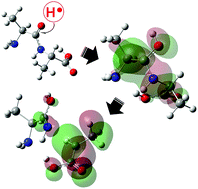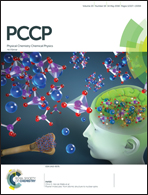Fundamental study of hydrogen-attachment-induced peptide fragmentation occurring in the gas phase and during the matrix-assisted laser desorption/ionization process
Abstract
Mass spectrometry with hydrogen-radical-mediated fragmentation techniques has been used for the sequencing of proteins/peptides. The two methods, matrix-assisted laser desorption/ionization in-source decay (MALDI-ISD) and hydrogen attachment/abstraction dissociation (HAD) are known as hydrogen-radical-mediated fragmentation techniques. MALDI-ISD occurs during laser induced desorption processes, whereas HAD utilizes the association of hydrogen with peptide ions in the gas phase. In this study, the general mechanisms of MALDI-ISD and HAD of peptides were investigated. We demonstrated the fragmentation of four model peptides and investigated the fragment formation pathways using density functional theory (DFT) calculations. The current experimental and computational joint study indicated that MALDI-ISD and HAD produce aminoketyl radical intermediates, which immediately undergo radical-induced cleavage at the N–Cα bond located on the C-terminal side of the radical site, leading to the c′/z˙ fragment pair. In the case of MALDI-ISD, the z˙ fragments undergo a subsequent reaction with the matrix to give z′ and matrix adducts of the z fragments. In contrast, the c′ and z˙ fragments react with hydrogen atoms during the HAD processes, and various fragment species, such as c˙, c′, z˙ and z′, were observed in the HAD-MS/MS mass spectra.



 Please wait while we load your content...
Please wait while we load your content...